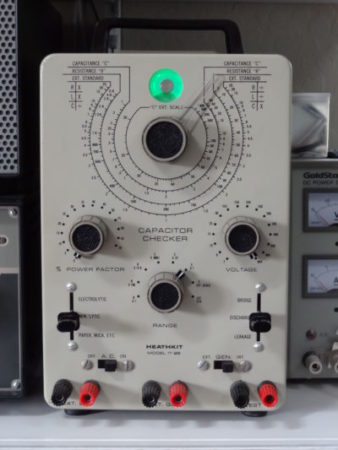Home › Forum › Ask A Member › OMC condensers. What is the micro farad and working voltage?
- This topic has 8 replies, 5 voices, and was last updated 10 months, 2 weeks ago by
outbdnut2.
-
AuthorPosts
-
February 9, 2025 at 1:02 am #293990
When going over some of the OMC outboards I pick up, some have had replacement ignition coils already installed in them and the later condensers with the black rubber boot where the lead comes out of them. I realize there is no way to tell the age of the components, but would anyone know what micro farad and the working voltage of new OMC condensers and also a good way to test the existing condensers to see if they are usable? Or would it be advisable to just put in new condensers. Thank You Bill,
February 9, 2025 at 9:33 am #2939962nd try reply went poof ???
.22uf is estimated to be the best all around value on late 40s to more “modern” magneto/points well into the 70s until they switched to CDI
Magazine Articles | Western Reserve Chapter
see all related articles on condensers how they work how to rebuild them
especially parts 1-4 !
Joining AOMCI has priviledges 🙂
February 9, 2025 at 12:23 pm #294001These seem to be working in my test barrel runs. A cheaper alternative to oem.
https://www.amazon.ca/dp/B07N1FJCF3?ref_=ppx_hzod_title_dt_b_fed_asin_title_0_0
February 9, 2025 at 12:25 pm #294002Capacitor Voltage rating is only a minimum number the part can tolerate. You can use a capacitor rated anywhere at or above that number. I don’t know the minimum for these magneto ignitions, but I think any capacitor rated at 600 Volts or higher would be OK for the maximum voltage spikes encountered at the primary side of the coil. Crosbyman’s recommendation of .22 uFd is good.
It’s a good idea when substituting capacitors that can’t be clamped or screwed down to attach them to the mag plate with silicone cement so they don’t vibrate until their lead wires break off.
Dave
February 9, 2025 at 1:25 pm #294003Well I claim no fame. M.Mohat tested a bunch and .22uf was his conclusion ( see his testing & chart ) . As to the brown caps I ordered a bunch of them few years ago and you confirm they work likeI suspected being 600V + and sturdy. Going on memory …. I am pretty certain properly insulated the will fit inside old emptied out cap cans for solid mounting. Just drill a small hole on the bottom and weld one wire to the can for grounding. the other end can be extended a bit and insulated from the can and connected to the points . A dab of epoxy or “corona” silicon in the can will hold them in place. 🙂
m.Mohat preferred the ceramic stuff $$$ at 850V but they are very tiny to work with and solder. I got some cheap ones from amazon but never got around to installing them in a cap. can.
Joining AOMCI has priviledges 🙂
February 9, 2025 at 9:06 pm #294025
I got this inexpensive mutli-meter at Harbor Freight that can tell you the value of your condensers. The reading is in nano farads though. As far as if they’re still good, you need a taster like a Merc O Tronic. How bad do you want to know? I have one and could test them for you if you wanted to send them to me.

A "Boathouse Repair" is one thats done without having tools or the skills to do it properly.
February 10, 2025 at 8:30 am #294029if you are into oldies much or will be after you are infected with the hobby… you can build your own load tester for caps. See Mr Mohat’s PART 2 article
I built his basic model and it has an idiot lamp for GOOD -NOT GOOD during a load tests at about 250V+
Joining AOMCI has priviledges 🙂
February 10, 2025 at 11:15 am #293995see all you need on condensers on the wester region aomci site where m.Mohat explains it all
Magazine Articles | Western Reserve Chapter
https://wrcoutboards.org/wp-content/uploads/2020/04/Part1_Condenser_Construction_Failure_Modes.pdf
https://wrcoutboards.org/wp-content/uploads/2020/04/Part3_Sizing_Condensers_Correctly.pdf
https://wrcoutboards.org/wp-content/uploads/2020/04/Part4_Repairing_Broken_Condensers.pdf
https://wrcoutboards.org/wp-content/uploads/2020/03/Articles_Ignition_Part3_Magic_Of_Magneto_r.pdf
Joining AOMCI has priviledges 🙂
February 10, 2025 at 8:26 pm #294034The tester Tubs showed is good for measuring capacitance (uFd), and if that is right, chances are good it will work, but it does not put a big voltage on them looking for leakage or breakdown. There aren’t many options for testing that do that. I use an old Heathkit capacitor checker that can put up to 600 volts on them. Works great!, but Heathkit is long gone and when they show up for sale, they aren’t cheap! With electronics being a hobby of mine as a kid that developed into a lifelong career, I bought mine new in the early 1960s and put the kit together. It is an electronics lab instrument. There are some on E-Bay right now, but I was really surprised at the prices. The kit I bought in the 1960s cost me $29. Link and photo below. I have a model IT-11 which is same as the IT-28 except for color.
Dave

-
AuthorPosts
- You must be logged in to reply to this topic.

